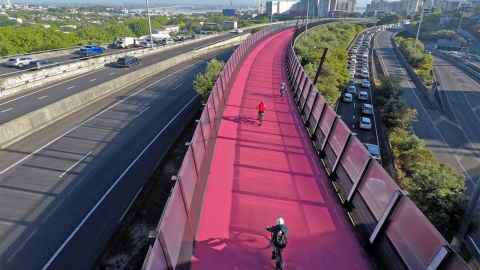Reducing health risks on your daily commute
22 July 2019
Opinion: What are you getting out of your daily commute? Kim Dirks considers the implications of how we get from A to B and the effect our options have on well-being.

The travel mode we choose for our daily commute, and even the specific route we choose, can have financial, environmental, health and social implications on our lives. It can also impact our mental well-being.
The positive health implications are around physical activity of course, and the benefits we experience from being able to get to work under our own steam.
Active commuters who can cycle, run or walk to work every day can meet very easily the Ministry of Health’s guidelines for the minimum amount of physical activity for adults of two and a half hours of moderate exercise or one and a half hours of vigorous activity a week.
So too, can people who use public transport. Buses and trains aren’t door-to-door so the modest walk between home and the bus stop, and the bus stop and work, may be the difference between getting no exercise and reaching the recommended target for many people.
It is commuters in this group, those who would otherwise be inactive, that benefit most from the exercise imposed by a physical commute. They stand to make greatest gains in reducing the risk of chronic disease and premature mortality by taking on this additional exercise.
And it’s not just adults commuting to work who benefit from taking an active approach to getting to where they need to be - walking school buses provide a great opportunity for children to incorporate physical activity into their daily routine, and of course, parents who help out also get the benefit.
Interestingly, a survey carried out by Dr Judith Wang (formerly a research fellow at the University of Auckland's School of Engineering and now an Associate Professor in Resilient Transportation at the University of Leeds) and colleagues on University of Auckland students and staff revealed that improving health and fitness was the number one motivator for cyclists to cycle on their daily commute.
But unsurprisingly, safety is one of the less positive health implications for this group, specifically accidents rates and air pollution.
According to Dr Wang’s survey, for those who cycle and those who indicated that they might consider cycling, the vast majority of the top route quality characteristics were to do with safety.
For those who might consider cycling, having a separate cycleway for the whole of their journey was the number one consideration.
While motorcyclists fare the worst when it comes to road traffic accidents, bicycle accident rates are also high relative to most other transport modes.
The Government recently announced its commitment to reduce New Zealand’ high road toll through its Vision Zero strategy.
It is commuters in this group, those who would otherwise be inactive, that benefit most from the exercise imposed by a physical commute. They stand to make greatest gains in reducing the risk of chronic disease and premature mortality by taking on this additional exercise.
While reducing road accidents is at the centre of this strategy, the government is also committed to addressing the broader harms of road traffic to health, including air and noise pollution.
Large differences in air pollution exposure can be seen between modes of commuting.
Generally, the further you are separated from the main line of traffic, the lower the air pollution concentration you are exposed to.
Even travelling on the edge of a road rather than down the centre lane can be helpful in reducing exposure. Separate cycleways and footpaths, even those providing an extra few meters can be particularly effective.
The extra protection they provide from road traffic accidents is also very significant.
Even when such infrastructure does not exist, individuals can reduce their exposure simply by walking on the side of the road where there is less traffic (opposite rush hour traffic), walking along a quieter street or through a park rather than along a road, where possible.
While parks can be considered a safety concern, especially at night, they do provide the opportunity for a ‘green experience’ though contact with nature.
Even modest amounts of time spent in green environments such as parks has been shown to improve heath through stress reduction, better sleep, more pleasant soundscapes (nature sounds rather than the sound of road traffic) and pleasant views.
During the summer, parks can also help by providing shade and providing protection from harmful UV rays.
If you suffer from allergies, then perhaps the benefits of the green experience might be outweighed by the annoying effects of an allergic reaction.
The healthiest way to travel is personal and depends on a number of factors, including the journey to work needed, the transport options available, the extent of transport infrastructure available (bus and train routes and scheduling, and available cycleways).
It also depends on an individual’s level of mobility, cultural and social expectations and habits.
What works best for one person may not be the best for another, but what we need is a range of options that will help to improve health and well-being and minimise the negative consequences.
Associate Professor Kim Dirks is Head of Department in Epidemiology and Biostatistics at the Faculty of Medical and Health Sciences.
This article reflects the opinion of the author and not necessarily the views of the University of Auckland.
Used with permission from Newsroom Reducing health risks on your daily commute on 22 July 2019.
Media queries
Alison Sims | Research Communications Editor
DDI 09 923 4953
Mob 021 249 0089
Email alison.sims@auckland.ac.nz